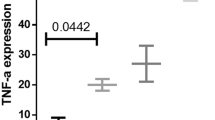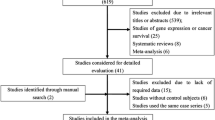Abstract
Tumor necrosis factor alpha (TNF-α) is a vital cytokine involved in inflammation, immunity, and cellular organization. The TNFA-308G/A (rs1800629) and -238G/A (rs361525) polymorphisms are two widely investigated variants for their associations with risk of cervical cancer, but the results are conflicting. Here, we performed a meta-analysis to pool the data and evaluate the between-studies heterogeneity. All the case–control studies published from January 1989 to October 2010 on the association between the two polymorphisms of TNFA and cervical cancer risk were identified by searching the electronic literature Medline. The cervical cancer risk associated with the two polymorphisms of TNFA gene was estimated for each study by OR together with its 95% CI, respectively, by using the Review Manager 4.2 software. It was showed that the variant homozygote -308AA was associated with a significantly increased risk of cervical cancer (AA vs. GG: OR = 1.41, 95% CI = 1.03–1.92, P = 0.033; AA vs. GA/GG: OR = 1.39, 95% CI = 1.02–1.90, P = 0.036), and the effect was more evident among Asians (AA vs. GA/GG: OR = 3.67, 95% CI = 1.25–10.81, P = 0.018). We also found that the variant genotypes -238GA/AA was associated with a significantly decreased risk of cervical cancer (GA/AA vs. GG: OR = 0.55, 95% CI = 0.41–0.74, P < 0.001). The results suggested that TNFA-308G/A and -238G/A may contribute to cervical cancer susceptibility.


Similar content being viewed by others
References
Parkin DM, Bray F, Ferlay J et al (2005) Global cancer statistics, 2002. CA Cancer J Clin 55(2):74–108
Muñoz N, Bosch FX, de Sanjosé S et al (2003) Epidemiologic classification of human papillomavirus types associated with cervical cancer. N Engl J Med 348(6):518–527
Chen X, Han S, Wang S et al (2009) Interactions of IL-12A and IL-12B Polymorphisms on the susceptibility of cervical cancer in Chinese women. Clin Cancer Res 15(1):400–405
Santos AM, Sousa H, Catarino R et al (2005) TP53 codon 72 polymorphism and risk for cervical cancer in Portugal. Cancer Genet Cytogenet 159(2):143–147
Ho GY, Bierman R, Beardsley L et al (1998) Natural history of cervicovaginal papillomavirus infection in young women. N Engl J Med 338(7):423–428
Strieter RM, Kunkel SL, Bone RC (1993) Role of tumor necrosis factor-alpha in disease states, inflammation. Crit Care Med 21(10 Suppl):S447–S463
Ardizzoia A, Lissoni P, Brivio F et al (1992) Tumor necrosis factor in solid tumors: increased blood levels in the metastatic disease. J Biol Regul Homeost Agents 6(3):103–107
Wilson AG, Symons JA, McDowell TL et al (1997) Effects of a polymorphism in the human tumor necrosis factor alpha promoter on transcriptional activation. Proc Natl Acad Sci USA 94(7):3195–3199
Fong CL, Siddiqui AH, Mark DF (1994) Identification and characterization of a novel repressor site in the human tumor necrosis factor ogene. Nucl Acids Res 22(6):1108–1114
Singh H, Jain M, Sachan R et al (2009) Association of TNFA (-308G>A) and IL-10 (-819C>T) promoter polymorphisms with risk of cervical. Int J Gynecol Cancer 19(7):1190–1194
Wang SS, Bratti MC, Rodríguez AC (2009) Common variants in immune and DNA repair genes and risk for human papillomavirus persistence and progression to cervical cancer. J Infect Dis 199(1):20–30
Duarte I, Santos A, Sousa H et al (2005) G-308A TNF-alpha polymorphism is associated with an increased risk of invasive cervical cancer. Biochem Biophys Res Commun 334(2):588–592
Calhoun ES, McGovern RM, Janney CA et al (2002) Host genetic polymorphism analysis in cervical cancer. Clin Chem 48(8):1218–1224
Ivansson EL, Juko-Pecirep I, Gyllensten UB (2010) Interaction of immunological genes on chromosome 2q33 and IFNG in susceptibility to cervical cancer. Gynecol Oncol 116(3):544–548
Stanczuk GA, Sibanda EN, Tswana SA et al (2003) Polymorphism at the -308-promoter position of the tumor necrosis factor-alpha (TNF-alpha) gene, cervical cancer. Int J Gynecol Cancer 13(2):148–153
Gostout BS, Poland GA, Calhoun ES et al (2003) TAP1, TAP2, HLA-DR2 alleles are predictors of cervical cancer risk. Gynecol Oncol 88(3):326–332
Jang WH, Yang YI, Yea SS et al (2001) The -238 tumor necrosis factor-alpha promoter polymorphism is associated with decreased susceptibility to cancers. Cancer Lett 166(1):41–46
Govan VA, Constant D, Hoffman M et al (2006) The allelic distribution of -308 tumor necrosis factor-alpha gene polymorphism in South African women with cervical cancer and control women. BMC Cancer 6:24
Deshpande A, Nolan JP, White PS et al (2005) TNF-alpha promoter polymorphisms and susceptibility to human papillomavirus 16-associated cervical cancer. J Infect Dis 191(6):969–976
Kohaar I, Thakur N, Salhan S et al (2007) TNFalpha-308G/A polymorphism as a risk factor for HPV associated cervical cancer in Indian population. Cell Oncol 29(3):249–256
Zintzaras E, Ioannidis JP (2005) Heterogeneity testing in meta-analysis of genome searches. Genet Epidemiol 28(2):123–137
Higgins JP, Thompson SG (2002) Quantifying heterogeneity in a meta-analysis. Stat Med 21(11):1539–1558
Egger M, Davey Smith G, Schneider M et al (1997) Bias in meta-analysis detected by a simple, graphical test. BMJ 315(7109):629–634
Dinarello CA, Wolff SM (1993) The role of interleukin-1 in disease. N Engl J Med 328(2):106–113
Tracey KJ, Cerami A (1993) Tumor necrosis factor, other cytokines and disease. Annu Rev Cell Biol 9:317–343
Carswell EA, Old LJ, Kassel RL et al (1975) An endotoxin-induced serum factor that causes necrosis of tumors. Proc Natl Acad Sci USA 72(9):3666–3670
Leibovich SJ, Polverini PJ, Shepard HM et al (1987) Macrophage-induced angiogenesis is mediated by tumour necrosis factor-alpha. Nature 329(6140):630–632
Woodworth CD, McMullin E, Iglesias M et al (1995) Interleukin 1 alpha and tumour necrosis factor alpha stimulate autocrine amphiregulin expression and proliferation of human Papillomavirus-immortalized and carcinoma-derived cervical epithelial cells. Proc Natl Acad Sci USA 92(7):2840–2844
Bequet-Romero M, López-Ocejo O (2000) Angiogenesis modulators expression in culture cell lines positives for HPV-16 oncoproteins. Biochem Biophys Res Commun 277(1):55–61
Tjiong MY, van der Vange N, ter Schegget JS et al (2001) Cytokines in cervicovaginal washing fluid from patients with cervical neoplasia. Cytokine 14(6):357–360
Hajeer AH, Hutchinson IV (2001) Influence of TNF alpha gene polymorphisms on TNF alpha production and disease. Hum Immunol 62(11):1191–1199
Kroeger KM, Carville KS, Abraham LJ (1997) The -308 tumor necrosis factor-alpha promoter polymorphism effects transcription. Mol Immunol 34(5):391–399
Kaluza W, Reuss E, Grossmann S et al (2000) Different transcriptional activity and in vitro TNF-alpha production in psoriasis patients carrying the TNF-alpha 238A promoter polymorphism. J Invest Dermatol 114:1180–1183
Li N, Franceschi S, Howell-Jones R et al (2011) Human papillomavirus type distribution in 30,848 invasive cervical cancers worldwide: variation by geographical region, histological type and year of publication. Int J Cancer 128(4):927–935. doi:10.1002/ijc.25396
Acknowledgments
This work was supported in part by the Program for Changjiang. Scholars and Innovative Research Team in University (IRT0631); Key Project of Nanjing Medical University (07NMUZ011), Natural Science Foundation of Jiangsu Colleges (08KJB330002) and Project for Public Technology Service Center for Reproductive Health in Humans (BM2007709 and BM2008151).
Author information
Authors and Affiliations
Corresponding author
Additional information
Li Liu and Xi Yang contributed equally to this work.
Rights and permissions
About this article
Cite this article
Liu, L., Yang, X., Chen, X. et al. Association between TNF-α polymorphisms and cervical cancer risk: a meta-analysis. Mol Biol Rep 39, 2683–2688 (2012). https://doi.org/10.1007/s11033-011-1022-9
Received:
Accepted:
Published:
Issue Date:
DOI: https://doi.org/10.1007/s11033-011-1022-9




